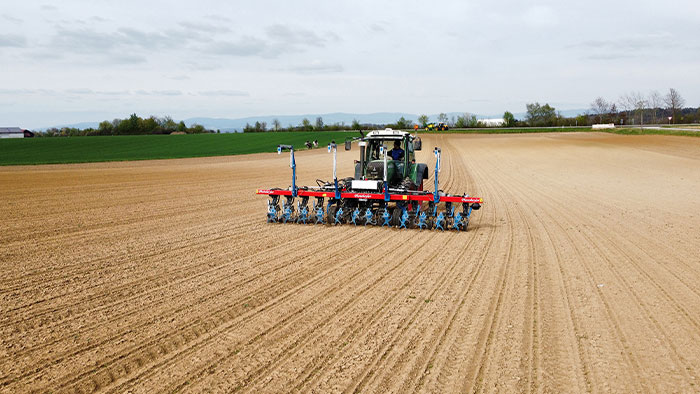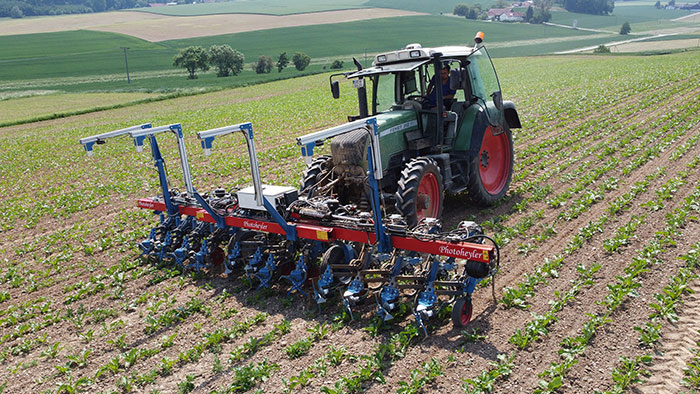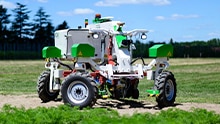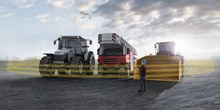The Photoheyler hoeing systems of the consultancy firm Planungsbüro Heinrich are revolutionizing automated weeding. They enable the specially shaped rotors on the tractor attachment to remove weeds in plant rows with maximum precision without damaging the crops or covering them with soil. Singleturn AFS60 absolute encoders that have been modified for agricultural use ensure a perfect posi-tioning of these rotating tools in the field.
Inox encoders position manual hoeing tools when weeding
Mechanical weed control in plant rows by humans is tedious work – and the automated alternatives available to date have been slow. But the use of pesticides to combat weeds is not a desired or sustainable alternative over the long term. With its Photoheyler hoeing system, Planungsbüro Heinrich in Oberschneiding has established a new “hoeing discipline” in the market for automated weed removal. Cultivated plants from the two-leaf stage to commencement of row closure can be hoed with an output of more than one hectare per hour. The hydraulically driven rotors that remove the weeds from the plant row adjust the speed of the agricultural machinery so the cultivated plants, e.g. sugar beet, are not damaged or covered by the soil displaced in the direction of travel while trimming plants vertically.
The fast and precise absolute Inox encoders in the AFS60 EtherCAT product family ensure a dynamic position detection and speed measurement for the twelve individual trajectory-controlled rotors in total on the tractor attachment. The encoders are also a further example of the customer-focused development of sensor solutions at SICK: the AFS60 EtherCAT was quickly adapted from its actual industrial use to the agricultural-related application in the Photoheyler.
Customized solution strengthened for field work
To specifically adapt the sensor for field work on the Photoheyler and possibly other applications in the agricultural domain or heavy duty applications, the customizing experts at SICK in collaboration with the customer totally redesigned the sensor. The aluminum housing was replaced by a housing made from stainless steel. This also required modifi-cation of the socket-plug connection to enable a better effectiveness of the seal to be achieved. Furthermore, the enclosure rating of the flange side of the housing, which was originally IP65, is now rated at IP67 to prevent penetration of moisture via the ball bearing of the encoder. Planungsbüro Heinrich extensively tested the first sample of the “Agricul-tural AFS60” and confirmed that the sensor now meets all requirements as a result of the customer-specific and application-specific adaptations.
High precision and data speed: absolute encoder allows bespoke weeding

detection rates of over 98 percent,” explains Dr. Stefan Heinrich from the consultancy firm of the same name. “At the same time, the cameras measure, for each plant row, the distance between the crop plants because the plant spacings can vary over time as the plants grow even if they were sown uniformly by machine.” To be able to remove the weeds in a targeted manner, the trajectory of each individual rotor must therefore be controlled. This in turn requires that each hydraulic drive on the tractor attachment have its own encoder that can quickly and precisely deliver position and speed measurement values for controlling the hoeing rotors. After other models were found to be unsuitable for technical or economic reasons, the consultancy firm chose the compact and cost-effective absolute encoders in the AFS60 EtherCAT product family from SICK. These provide a singleturn resolution of 18 bits for 360° position detection and the required accuracy for precise control. “The EtherCAT version also allows us achieve cycle times of just four milliseconds and therefore the necessary dynamic control for the slowing down and acceleration of the rotors.” explains Dr. Stefan Heinrich.
One-stop supply for agricultural machinery sensors
The example of the AFS60 EtherCAT Inox for the Photoheyler application demonstrates that the products and systems in the existing portfolio can, through efficient customizing, be modified for a diverse range of new applications. For example, SICK can also provide the multiturn AFM60 EtherCAT absolute encoder in the described version in a short amount of time if required. This means encoders are available for the technology and automation of agricultural machinery that can measure the speed of the moving, usually rotating parts of agricultural machinery, detect the position of mobile components and attachments, and thereby optimize, for example, soil cultivation or harvesting, and which are able to assist with the control of autonomous steering and driving systems.
The company also offers a wide variety of sensor solutions, for example initiators or ultrasonic sensors, which Planungsbüro Heinrich purchases from SICK as a one-stop supplier for use in the Photoheyler and other machinery. SICK's sensor and systems technology can also cater for Farming 4.0 – the digitalization of agriculture. Numerous sensors – including the AFS/AFM60 encoder ؘ– offer smart diagnostic functions for efficient condition monitoring. Or they allow the process-optimized operation of agricultural machinery: combine harvesters that autonomously navigate collision-free along the crop edge, harvesting robots that only pick truly ripe fruit, booms that spray pesticide only on weeds in a targeted manner, transfer vehicles that independently detect their fill level, or warehouses and silos that automatically determine and report the delivered harvest volume. SICK offers a comprehensive portfolio for these and many other applications. “The range extends from standard sensors with different physical principles of operation, smart encoders, inclination sensors, sensors for environment perception with integrated application algorithms, right through to complex systems as well as IoT and cloud based solutions,” explains Tobias Brader from the sales department who focuses in particular on mobile automation customers. All sensors relevant to agricultural technology are designed in such a way as to meet the stringent requirements on impermeability, temperature influences, EMC immunity as well as shock and vibration resistance in their typically harsh operational environments – in either their factory standard versions, or through efficient customizing as for the Photoheyler.









